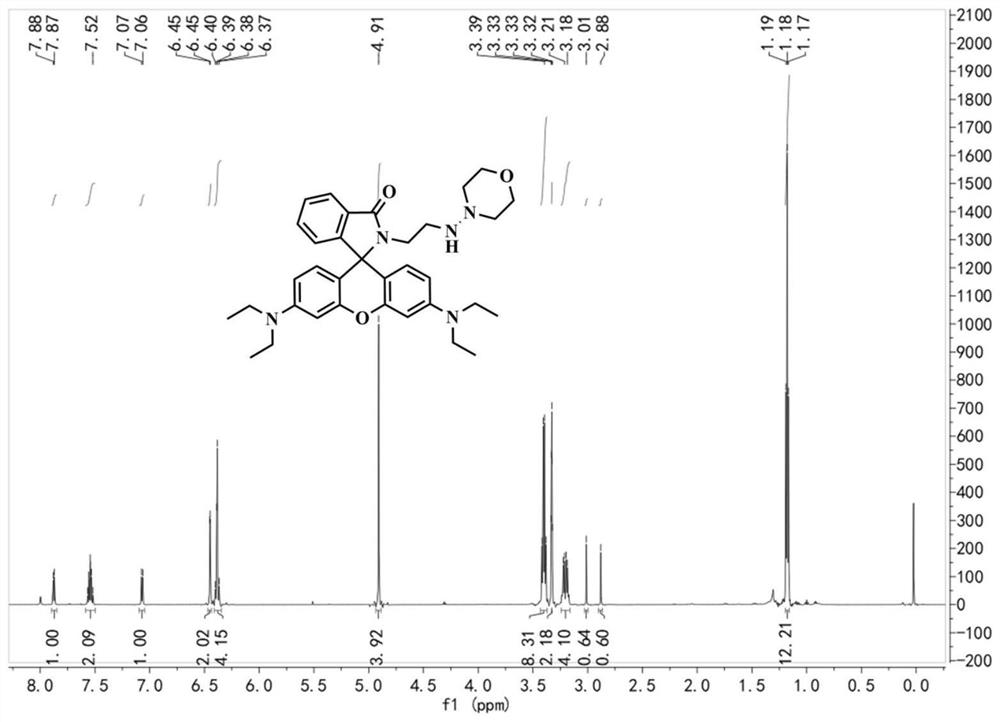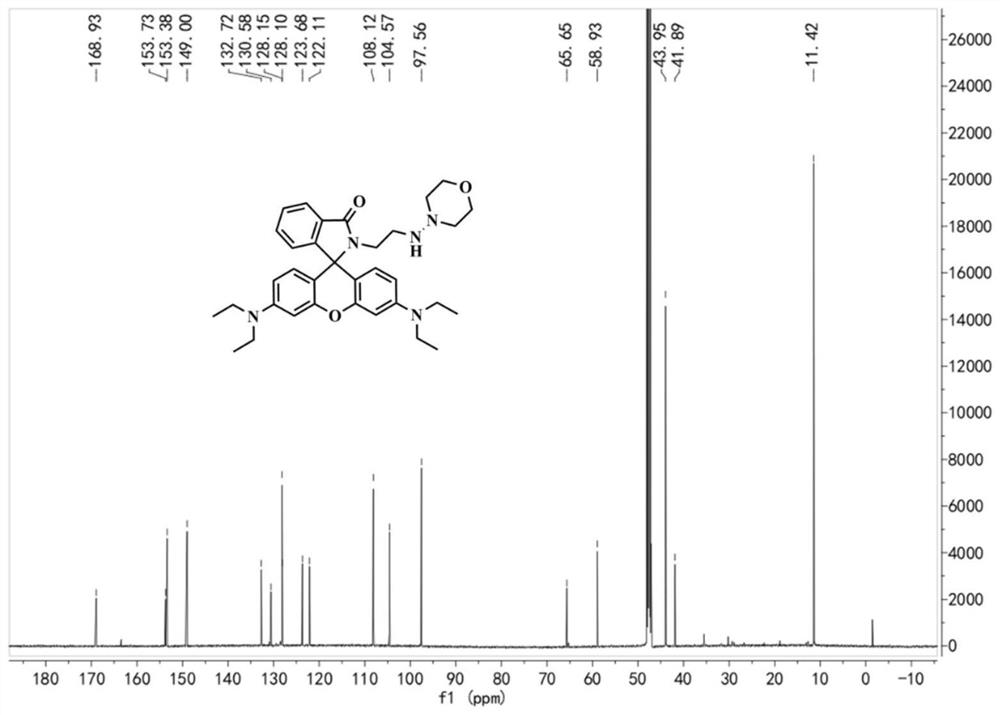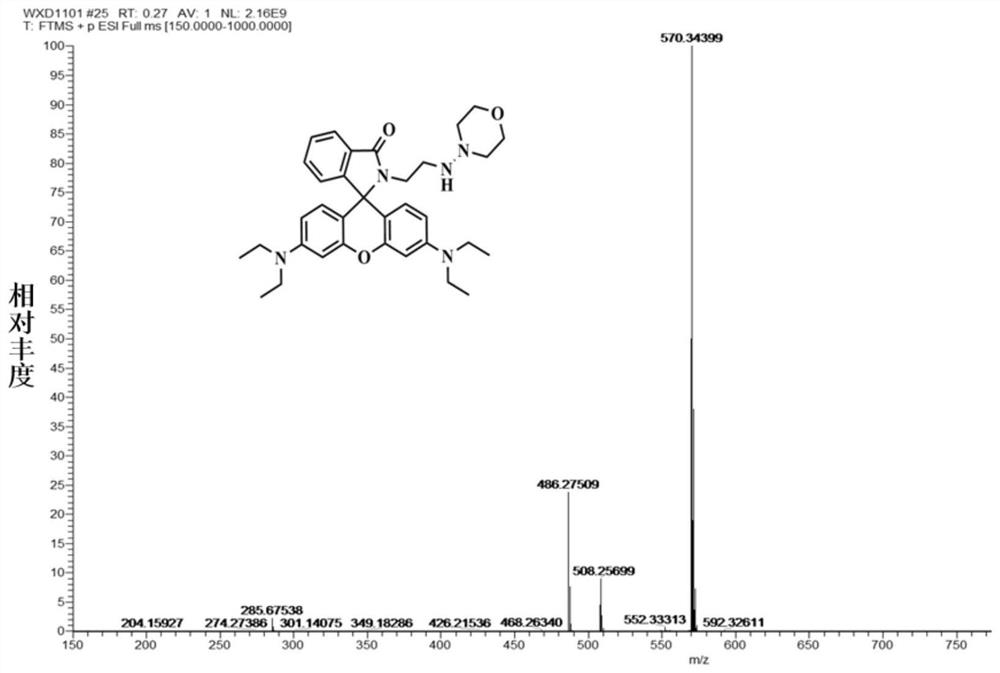Rhodamine-like pH fluorescent probe for monitoring mitophagy and its preparation and application
A technology for mitophagy and fluorescent probes, applied in the field of pH fluorescent probes, can solve the problems of strong background fluorescence, large cytotoxic side effects, and unsuitable for cell monitoring, and achieve simple detection methods, easy large-scale production, and good cell membranes. permeability effect
- Summary
- Abstract
- Description
- Claims
- Application Information
AI Technical Summary
Problems solved by technology
Method used
Image
Examples
Embodiment 1
[0031] 3',6'-Bis(diethylamino)-2-(2-(aminomorpholine)ethyl)spiro[isoindoline-1,9'-xanthene]-3-one (MSO) Preparation and characterization:
[0032]
[0033] In a round-bottomed flask, dissolve the N-p-toluenesulfonic acid ethyl ester derivative of rhodamine B (170mg, 0.62mmol) and N-aminomorpholine (300mg, 0.93mmol) in dichloromethane, and heat to reflux for 12h to The reaction was complete; the system was cooled to room temperature, and the solvent was removed by rotary evaporation under reduced pressure to obtain a crude product; the crude product was purified by silica gel column (eluent by volume ratio of dichloromethane: anhydrous methanol = 20:1) to obtain a light yellow solid as the target compound for monitoring MSO, a rhodamine-based pH fluorescent probe for mitophagy.
[0034] 1 H NMR (600MHz, CD 3 OD-d 4 , Figure 1a )δ(ppm):1.17-1.19(t,12H,-CH 3 -),2.88-3.01(d,2H,-CH 2 -),3.18-3.22(m,4H,-CH 2 -),3.32-3.33(m,2H,-CH 2 -),3.38-3.42(m,8H,-CH 2 -),4.91(s,4H,-...
Embodiment 2
[0038] Dilute the probe to a final concentration of 5 μM with Britton-Robinson buffer at different pH values, fix the excitation wavelength at 574 nm, and record the fluorescence of the fluorescent probe MSO in the DMSO / BR (1 / 99, v / v) system as it changes with pH The emission spectrum changes. As the pH value decreased from 8.0 to 4.8, the fluorescence intensity at 590nm gradually increased ( image 3 ). At the same time, the fluorescent color of the solution changed from colorless to pink ( Figure 4 ). According to the Singmoidal fitting curve calculation of the fluorescence intensity value of the fluorescent probe MSO at 590nm as a function of pH, the pKa value is 5.42 ( Figure 5 ), the pH response linear range is 5.0-6.0, which is very suitable for the detection of pH changes in the weakly acidic environment of lysosomes.
Embodiment 3
[0040] The concentration of the fluorescent probe MSO in Example 1 was maintained at 5 μM, and the probe was investigated in the presence of common ions and amino acids for H + selectivity. Such as Figure 6 As shown, in the DMSO / BR (1 / 99, v / v) system, at pH 8.0 and pH 5.0, the fluorescent probe RML has almost no response to the above substances, which proves that the fluorescent probe RML has no response to the H + Has high selectivity. Figure 6 The sequence and concentration of the substances in the sequence are: 1, blank; 2, K + (150mM),3,Na + (150mM),4,Mg 2+ (2mM),5,Ca 2+ (2mM),6,Ba 2+ (0.2mM),7,Cu 2+ (0.2mM),8,Fe 2+ (0.2mM),9,Fe 3+ (0.2mM),10,Ni 2+ (0.2mM),11,Zn 2+ (0.2mM),12,Cl - (10mM),13,SO 4 2- (0.2mM),14,SO 3 2- (0.2mM),15,NO - (0.2mM),16,Ac - (0.2mM),17,Al 3+ (0.2mM),18,Ag + (0.2mM),19,Br - (0.2mM),20,Cd 2+ (0.2mM),21,Cu 2+ (0.2mM),22,Mn 2+ (0.2mM),23,Cys(0.1mM),24,GSH(0.1mM),25,Hcy(0.1mM),26,Ala(0.1mM),27,His(0.1mM),28,Arg(0.1 mM),29,Lys(0...
PUM
 Login to View More
Login to View More Abstract
Description
Claims
Application Information
 Login to View More
Login to View More - R&D
- Intellectual Property
- Life Sciences
- Materials
- Tech Scout
- Unparalleled Data Quality
- Higher Quality Content
- 60% Fewer Hallucinations
Browse by: Latest US Patents, China's latest patents, Technical Efficacy Thesaurus, Application Domain, Technology Topic, Popular Technical Reports.
© 2025 PatSnap. All rights reserved.Legal|Privacy policy|Modern Slavery Act Transparency Statement|Sitemap|About US| Contact US: help@patsnap.com



